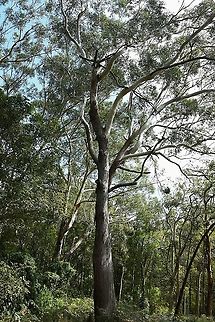
Appearance
''Eucalyptus pilularis'' is a tree that typically grows to a height of 70 m but does not form a lignotuber. It has finely fibrous, greyish brown bark on the lower half of the trunk, white to grey or cream-coloured bark above, often with insect scribbles.Young plants have stems that are more or less square in cross-section and leaves that are dull green, paler on the lower surface, sessile and mostly arranged in opposite pairs.
The juvenile leaves are lance-shaped, 55–130 mm long and 10–36 mm wide. Adult leaves are arranged alternately, more or less the same shade of glossy green on both sides, lance-shaped or curved, 75–170 mm long and 12–32 mm wide, tapering to a petiole 8–22 mm long.
The flowers are arranged in leaf axils in groups of between seven and fifteen on a flattened, unbranched peduncle 8–20 mm long, the individual buds on pedicels 2–7 mm long.
Mature buds are oval to club-shaped or spindle-shaped, 6–10 mm long and 3–5 mm wide with a conical to beaked operculum. Flowering mainly occurs from January to April or from October to December and the flowers are white. The fruit is a woody, hemispherical, shortened spherical or oval capsule 5–11 mm long and 7–12 mm wide with four valves near rim level or below it.
Naming
''Eucalyptus pilularis'' was first formally described in 1797 James Edward Smith in ''Transactions of the Linnean Society of London''. The species name is a Latin word meaning "a small pill", referring to the shape of the fruit.Within the genus ''Eucalyptus'', it lies in the subgenus ''Eucalyptus'' and the section ''Pseudophloius'', a group united by rough but not stringy bark, large opposite juvenile and glossy green adult leaves. Their leaves have adensely reticulated pattern, and the seed is red-brown, and smooth and pyramidal in shape.
Distribution
Found in wet sclerophyll or grassy coastal forests. North from Eden on the far south coast of New South Wales up to south eastern Queensland. The latitudinal range is 37.5 to 25.5 degrees south of the equator.Usually seen at low to mid altitudes, though growing at 800 metres above sea level near Wauchope, where it is a dominant species. Usually seen on coastal sandy loams, but also grows well on clays and volcanic soils. Reaches large size on drier slopes near rainforest.
The rainfall range is between 900 mm and 2000 mm per year. The climate for much of the distribution range is warm and humid. The mean minimum of the coldest month is around 5 to 10 degrees C, and 24 to 32 degrees C for the hottest month mean temperature. Frosts may occur in some sites away from the coast and at higher altitude.
References:
Some text fragments are auto parsed from Wikipedia.